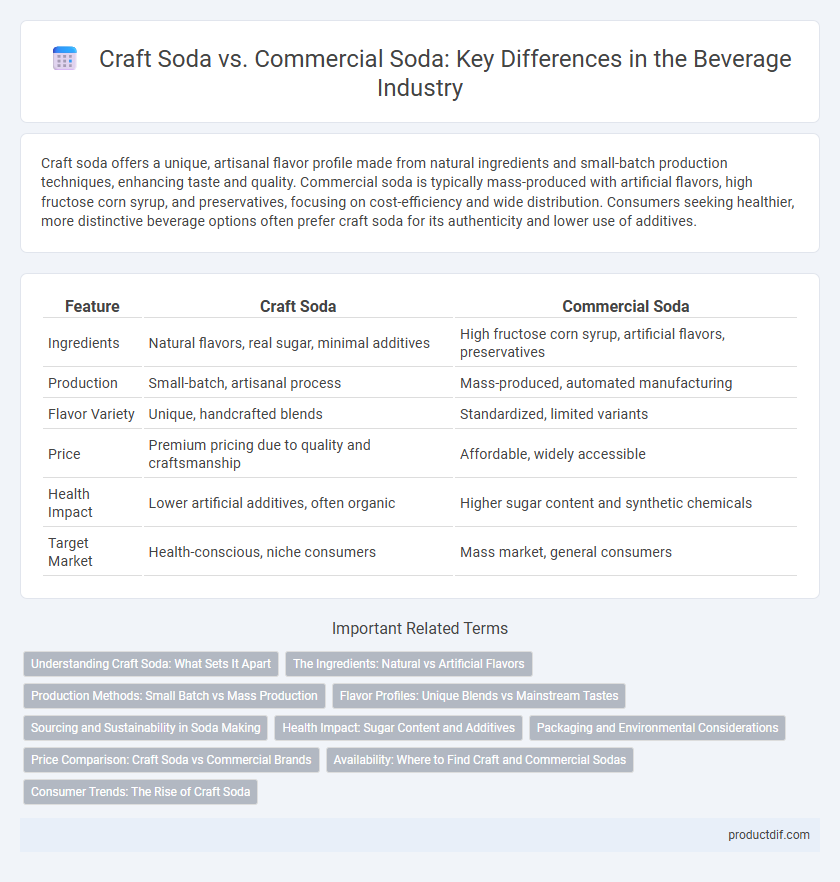Craft soda offers a unique, artisanal flavor profile made from natural ingredients and small-batch production techniques, enhancing taste and quality. Commercial soda is typically mass-produced with artificial flavors, high fructose corn syrup, and preservatives, focusing on cost-efficiency and wide distribution. Consumers seeking healthier, more distinctive beverage options often prefer craft soda for its authenticity and lower use of additives.
Table of Comparison
| Feature | Craft Soda | Commercial Soda |
|---|---|---|
| Ingredients | Natural flavors, real sugar, minimal additives | High fructose corn syrup, artificial flavors, preservatives |
| Production | Small-batch, artisanal process | Mass-produced, automated manufacturing |
| Flavor Variety | Unique, handcrafted blends | Standardized, limited variants |
| Price | Premium pricing due to quality and craftsmanship | Affordable, widely accessible |
| Health Impact | Lower artificial additives, often organic | Higher sugar content and synthetic chemicals |
| Target Market | Health-conscious, niche consumers | Mass market, general consumers |
Understanding Craft Soda: What Sets It Apart
Craft soda distinguishes itself through artisanal ingredients, small-batch production, and unique, robust flavors that often emphasize natural sweeteners and botanical extracts. Unlike commercial sodas that prioritize mass production and uniform taste with high-fructose corn syrup and artificial additives, craft sodas focus on quality, authenticity, and innovative blends. This approach appeals to consumers seeking healthier, more flavorful alternatives with a distinct artisanal character.
The Ingredients: Natural vs Artificial Flavors
Craft soda often contains natural flavors derived from real fruits, herbs, and spices, ensuring a more authentic and nuanced taste profile. Commercial sodas typically rely on artificial flavors and high fructose corn syrup to achieve consistency and lower production costs. The use of natural ingredients in craft sodas appeals to health-conscious consumers seeking fewer synthetic additives and preservatives.
Production Methods: Small Batch vs Mass Production
Craft soda is produced in small batches using artisanal methods that emphasize natural ingredients, bespoke flavors, and meticulous quality control, resulting in unique and diverse taste experiences. In contrast, commercial soda relies on mass production techniques with standardized recipes, automated processes, and preservatives to ensure consistency, scalability, and extended shelf life. The small batch approach in craft soda allows for greater experimentation and freshness, while commercial soda's mass production prioritizes efficiency and widespread distribution.
Flavor Profiles: Unique Blends vs Mainstream Tastes
Craft soda offers unique flavor profiles achieved through artisanal blends of natural ingredients, often featuring exotic fruits, herbs, and spices that create distinct and complex tastes. Commercial soda typically emphasizes mainstream flavors with consistent sweetness and carbonation, relying on widely recognized profiles like cola, lemon-lime, or root beer to appeal to a broad audience. The nuanced and innovative flavor combinations in craft soda attract consumers seeking originality and a more authentic beverage experience compared to the standardized, mass-produced taste of commercial sodas.
Sourcing and Sustainability in Soda Making
Craft soda prioritizes sourcing natural, often organic ingredients from local farmers, emphasizing sustainability through reduced carbon footprints and environmentally friendly practices. Commercial soda production frequently relies on mass-produced, synthetic ingredients sourced globally, resulting in higher environmental impact due to large-scale manufacturing and extensive transportation. Sustainable soda making in the craft sector involves transparent supply chains and minimal use of artificial additives, aligning with growing consumer demand for eco-conscious beverages.
Health Impact: Sugar Content and Additives
Craft soda typically contains lower sugar levels and fewer artificial additives compared to commercial soda, making it a healthier choice for consumers seeking natural ingredients. The absence of high fructose corn syrup and synthetic preservatives in craft soda reduces risks associated with metabolic disorders and chronic inflammation. In contrast, commercial sodas often have excessive sugar content and numerous additives that contribute to obesity, diabetes, and other health complications.
Packaging and Environmental Considerations
Craft soda packaging often utilizes glass bottles or recyclable materials that emphasize sustainability and minimal environmental impact. Commercial sodas typically rely on plastic bottles or aluminum cans with less focus on eco-friendly design, contributing to higher waste and pollution levels. Consumers increasingly favor craft soda brands for their commitment to reducing carbon footprints through innovative, biodegradable, or reusable packaging solutions.
Price Comparison: Craft Soda vs Commercial Brands
Craft soda typically commands higher prices due to small-batch production, premium ingredients, and artisanal methods, often ranging from $2 to $5 per bottle. Commercial soda brands benefit from large-scale manufacturing, bulk purchasing, and extensive distribution networks, resulting in lower costs, usually around $0.50 to $1 per can or bottle. Price differences reflect not only production scales but also consumer willingness to pay for unique flavors and healthier ingredient profiles found in craft sodas.
Availability: Where to Find Craft and Commercial Sodas
Craft sodas are typically found in specialty stores, farmers' markets, and select cafes, catering to consumers seeking unique, small-batch flavors. Commercial sodas dominate grocery stores, convenience stores, and vending machines worldwide, ensuring widespread availability and brand familiarity. While commercial sodas offer consistent accessibility, craft sodas provide limited distribution, often encouraging local or regional exploration.
Consumer Trends: The Rise of Craft Soda
The rise of craft soda reflects growing consumer demand for unique, natural, and artisanal beverage options that prioritize quality ingredients and innovative flavors over mass production. Craft soda brands leverage organic sweeteners, botanical infusions, and small-batch brewing techniques to cater to health-conscious and flavor-seeking consumers. This trend has led to increased market share for craft soda as consumers shift away from traditional commercial soda dominated by high-fructose corn syrup and synthetic additives.
Craft Soda vs Commercial Soda Infographic

 productdif.com
productdif.com